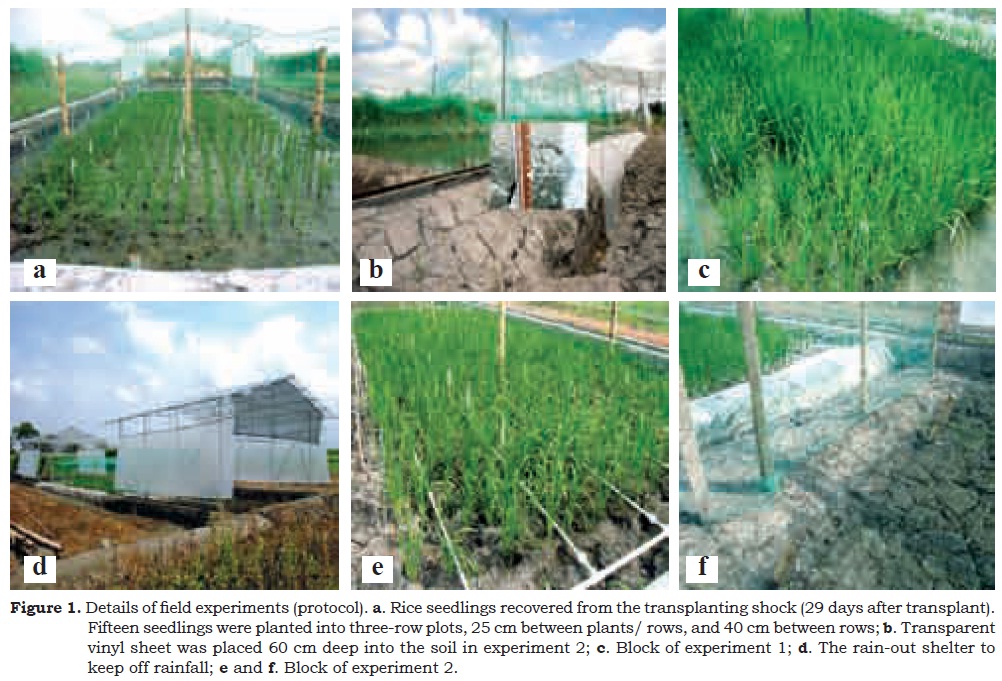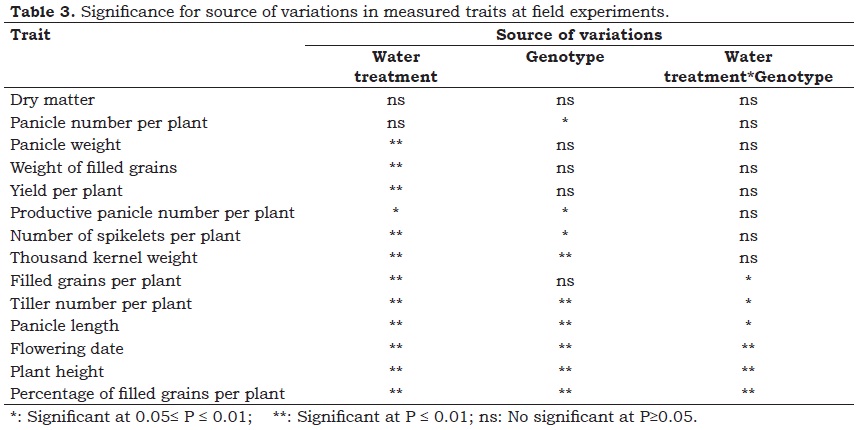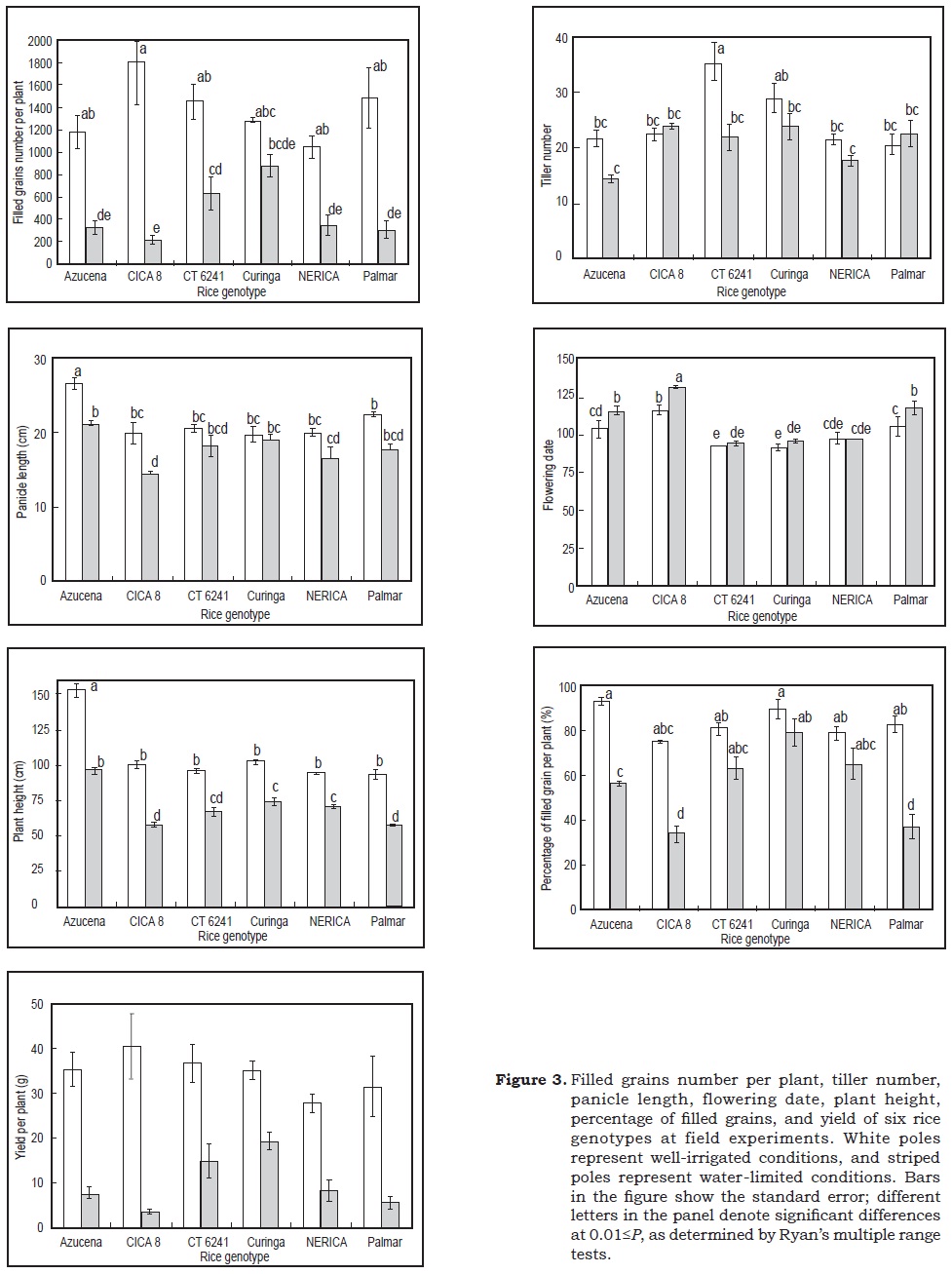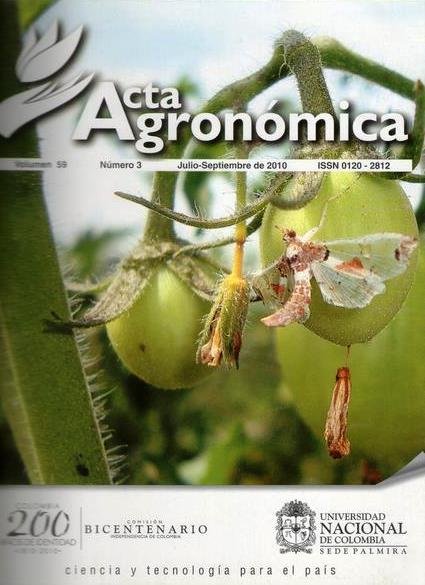Establishment of drought screening protocols for rice under field conditions
Palabras clave:
Rice, oryza, drought, yield, yield components (en)Rice, oryza, drought, yield, yield components (es)
1Facultad de Ciencias Agropecuarias, Universidad Nacional de Colombia sede Palmira A.A. 237. Palmira, Valle, del Cauca Colombia. 2Centro Internacional de Agricultura Tropical, CIAT, A.A. 6713 Cali, Colombia. Autor para correspondencia: c.p.martinez@cgiar.org
Abstract
Protocols were established for screening rice genotypes for tolerance to water-limited conditions under field conditions. These protocols were successfully used to select the best genotypes for further experiments. Rice genotypes responded differently when subjected to water-limited conditions. Experiments conducted under field conditions indicated that rice genotypes Curinga and CT6241 performed much better in terms of grain yield under water-limited conditions than varieties Azucena, Nerica, CICA8 and Palmar. Curinga, CT6241, CICA8 and Palmar were selected for further studies. The first two genotypes are tolerant and whereas the last two are susceptible to water stress.
Key words: Rice, oryza, drought, yield, yield components
Se estableció un protocolo para la selección de genotipos de arroz tolerantes a déficit hídrico bajo condiciones de campo. El protocolo desarrollado permitió la separación de los genotipos evaluados por su tolerancia a estrés hídrico, los cuales respondieron en forma diferente. En condiciones limitantes de agua, los genotipos Curinga y CT6241 presentaron mejor comportamiento en términos de rendimiento que las variedades Azucena, CICA8, Nerica y Palmar. Curinga, CT6241, CICA8 y Palmar fueron seleccionados para estudios futuros. Los dos primeros como genotipos tolerantes y los dos últimos como susceptibles al estrés hídrico.
Palabra clave: Arroz, oryza, sequía, rendimiento, componentes de rendimiento
Water deficit, more commonly referred to as drought, has been, and continues to be the most limiting factor affecting food production, especially in areas with inadequate agriculture water resources (Pantuwan et al., 2002; Lanceras et al., 2004; Yue et al., 2005; Xiao et al., 2008). Therefore, with the global shortage of water, reducing water consumption in crop production is recognized as an essential strategy for sustainable agriculture (Xiao et al., 2008).
Rice (Oryza sativa) is one of the worlds most important staple foods. Rice grain yield and yield components have been known to be highly influenced by water supply. There are numerous studies about drought tolerance in rice. Use of yield as an index for adaptation to drought stress in rice (Garrity and OToole 1994; Atlin 2001) may be considered as a reasonable approach, as grain yield is a major attribute of interest in most plant breeding programs (Pantuwan et al., 2004). However, drought tolerance is a complex trait that involves various aspects of developmental, physiological, biochemical, and molecular adjustments. The objective of this study was to establish drought-screening protocols for rice under field conditions.
Six rice genotypes were used in this study (Table 1). The irrigated varieties CICA8 and Palmar (Indica type), and the upland line CT6241 (Japonica type) are three genotypes developed for Latin America. An upland Nerica variety generated by the Africa Rice Center (WARDA), Curinga (CT11251-7-2-M-M-BR1), a Brazilian commercial variety originated from CIAT in 2003 (Annual Report of IP-4 Project at CIAT, 2003) and Azucena (a Japonica rice of Philippine origin) were pre-selected as drought tolerant genotypes. All rice genotypes were tested under well-irrigated and drought stress conditions, respectively.

Field experiments were conducted between August 2006 and January 2007 at the rice farm of the International Center for Tropical Agriculture (CIAT) (03° 29' 43.2"N, 76° 21' 12.5"W, 995 m. a. s. n.) located in Palmira, Valle del Cauca, Colombia. The soil was slightly alkaline, low iron, clayey and classified as Typic Pellustert. Details of the soil physical and chemical properties are shown in Table 2.

Fifteen 23-days old seedlings per genotype were transplanted into three-row plots, with a distance of 25 cm between plants, and 40 cm between rows. Rice seedlings recovered from the transplanting shock approximately two weeks after transplanting (Figure 1-a). Field experiments were carried out following a randomized complete block design with three replications. Each experimental block was separated by a distance of 45 m from the neighboring block. A well-irrigated block (experiment 1) received standard irrigation practices served as the control treatment; and a water-limited block (experiment 2) simulated drought stress using a rain-out shelter with minimum irrigation. Total size of the experiments was 63 m2 for experiment 1 and 200 m2 for experiment 2, respectively. Each experimental block was covered with nets to avoid damage and seed dissemination by birds. Two individual experiments were well irrigated after plowing and harrowing for a month until transplanting in order to increase the availability of iron and other nutritional components in the soil. Additionally, a basic fertilization was applied. Its composition (per 10000 m2) was as follows: 280 kg of urea; 240 kg mono-ammonium phosphate; 15 kg zinc sulfate, 110 kg potassium chloride; and 35 kg of microelements.
Experiment 1 was surface-irrigated and kept under irrigated and normal optimum cultivation conditions. Experiment 2 created an artificial drought stress condition by stopping irrigation 26 days after transplanting, draining off the water and keeping off rainfall using the rain-out shelter. Furthermore, in order to prevent water movement from outside the experimental block, a transparent vinyl sheet was placed 60 cm deep into the soil (Figure 1-b). Water conditions in experiment 2 were as follows: the block was irrigated 2 - 3 times (approximately 420 lt water irrigation for 57.8 m2) per week providing the plants a minimum amount of water with sprinklers, starting at the vegetative stage of growth. These water conditions were maintained until one week before harvest (Figure 1-e).

Data collected from these experiments included yield, yield components, dry matter, flowering date, and plant height using three plants located at the center of each plot to avoid a border effect on experiments 1 and 2, respectively. Flowering dates were determined visually by measuring three plants that were selected at random and when these had 50% visible panicles. Plant height and panicle number were measured at about dough stage. These plants were harvested from each plot, and dried at 50 °C to determine total dry matter. The percentage of filled grains was calculated by counting filled and unfilled grains for each of the sampled panicles from harvested plants; grains were dried in a hot air oven at 50 °C for 7 days, and 1000 grain weight was calculated from the dry weight of filled grains divided by the total number of grains (filled +unfilled grains), then multiplied 1000 times.
Analysis of variance (Anova) based on two treatments combination model, where each treatment followed a randomized complete block design, was carried out. The subsequent multiple comparisons among the means of treatments, genotypes and treatments by genotype interactions were examined based on the Ryan-Einot-Gabriel- Welsch multiple range tests (Ryans multiple range tests). All statistical analyses were performed using SAS software (SAS Institute Inc. 2004, SAS/STAT®, 9.1).
Palmira is classified as a subtropical climate with 900 - 1000 mm precipitation per year. The difference between the maximum and minimum temperature ranged from 12 °C at the beginning of field experiments to less than 8 °C by the time of flowering (Figure 1). The amount of weekly total rainfall was high and well distributed during the reproductive stage, but rainfall declined by the time of crop maturity (Figure 2).

Water treatments had significant effect on all plant traits except on dry matter and panicle number per plant; genotypes performed differently in terms of plant traits (Table 3).

No significant difference was observed for panicle number due to water treatments, but there were genotypic differences (Table 4).
Water treatments affected productive panicle number, and significant differences were observed among genotypes. However, Ryans multiple range tests did not detect significant statistical differences of their interactions for productive panicle number (Table 8).


Of all the traits, tiller number per plant and flowering date behaved differently compared to other traits in their responses to water treatments (Figure 3). Particularly, tiller number of CICA8 and Palmar under water-limited conditions was higher than under normal irrigated conditions; however, these differences were not significant. Similarly, flowering time was significantly delayed in the case of Azucena, CICA8, and Palmar. These findings suggest that these genotypes have a strong dependence response to water supply.

These results probably indicate that a large tiller number was associated with panicle production among rice genotypes, and that genotypes respond differently to water treatments. CICA8 and Palmar (which were developed for well-irrigated conditions) had more non-productive panicles than productive panicles under water-limited conditions. Curinga showed a high percentage of productive tillers than other tested genotypes under water-limited conditions (data not shown).
Significant differences were observed due to the different water treatments and/or among evaluated rice genotypes for both panicle length and panicle weight. However, plant genotype by water treatment interaction was significant for panicle length only (Figure 3 and Table 5). Panicle weight of all tested genotypes under normal irrigation condition was heavier than those grown under waterlimited conditions. CICA8 and Palmar were highly affected by the effect of water treatments. Significant differences in the weight of filled grains were observed due to water treatments (Table 6).


No significant differences were observed for yield and yield components (number of spikelets, percentage of filled grains and thousand- kernel weights) between rice genotypes and water treatments interaction, except for percentage of filled grains (Figure 3; Table 7, Table 9 and Table 10). Water treatments highly affected the number of spikelets. Curinga had more spikelets under the drought stress treatment compared with other genotypes (Table 9). There were differences in the number of spikelets between the six genotypes studied. All tested rice genotypes produced more filled grains and higher percentage of filled grains under normal irrigated conditions. The effect of water treatments shown for these two traits was particularly clear in CICA8 and Palmar (Figure 3). No significant differences were observed in Curinga for neither filled grain number nor for percentage of filled grains due to water treatments.
There were differences in thousandkernel weights due to genotypes and water treatments (Table 10); however there were no significant differences for their interaction. Significant differences were observed for thousand-kernel weight in CICA8 and Palmar. This finding suggests that thousand-kernel weight is less affected by water treatments compared to other yield components (Table 10). To summarize our findings it can be said that water treatments affected yield components globally in all evaluated genotypes. Yield components of CT6241, Curinga and Nerica were less affected by water treatments; on the other hand, Azucena, CICA8 and Palmar were highly affected by water treatments. Curinga showed the best yield performance among evaluated rice genotypes under drought stress conditions (Figure 3).



Flowering date was highly affected by water treatments, genotypes and their interactions. Azucena, CICA8 and Palmar flowered around 100 D.A.S., and plant growth was delayed under water-limited conditions. In contrast, Curinga, CT6241 and Nerica were not affected by water treatments (Figure 3).
Significant differences were observed for plant height (Figure 3). In particular, Azucena showed a reduction of about 50 cm in plant height under water stress. Curinga, CT6241 and Nerica were less affected by both treatments (with or without water stress).
These results probably indicate that Curinga and CT6241 have a potential to perform similarly under both water treatments based on plant traits evaluated. Furthermore, these two genotypes showed a higher yield response than other genotypes under drought stress conditions. Azucena also responded well for some traits; however, flowering date and plant height of Azucena were considered not suitable for our purpose. On the other hand, these results clearly indicate that CICA8 and Palmar are susceptible to water-limited conditions such as those imposed in experiment 2. By using our protocol, breeders may be able to evaluate a good number of rice lines and discard drought susceptible lines from the breeding program and select only promising lines with vegetative drought resistance (Pantuwan et al., 2004). However, it is unclear whether genotypes developed by genetic transformation of drought susceptible genotypes will perform well under water-limited conditions. Curinga and CT6241 were selected due to good performance under water-limited conditions; CICA8 and Palmar were also chosen as drought intolerant genotypes to be used as control genotype under water-limited conditions.
Protocols were established for screening rice genotypes for tolerance to water-limited conditions under field conditions. These protocols were successfully used to select best genotypes for further experiments. Rice genotypes responded differently when subjected to water-limited conditions. Experiments conducted under field conditions indicated that rice genotypes Curinga, and CT6241 performed much better in terms of grain yield under-water limited conditions than Azucena, Nerica, CICA8 and Palmar. Therefore, Curinga, CT6241, CICA8 and Palmar were selected for further studies. The first two genotypes are tolerant whilst CICA8, and Palmar are susceptible to water stress. By using our protocol, breeders may be able to evaluate a good number of rice lines and discard drought susceptible lines from the breeding program and select only promising lines with vegetative drought resistance.
We thank J. Silva and J. B. Cuasquer, for helping with the statistical analysis; Universidad Nacional de Colombia, Sede Palmira and Centro Internacional de Agricultura Tropical (CIAT), for providing guidance, support and facilities to carry out this work; Dr. Takumasa Kondo (Corpoica) for critical review of this manuscript. We gratefully acknowledge funding from the Instituto Colombiano de Crédito Educativo y Estudios Técnicos en el Exterior (ICETEX), Colombia, for postgraduate study for Tomoko Sakai.
Annual report of IP-4 project at CIAT. 2003. Executive summary
Atlin, G.N. 2001. Breeding for Suboptimal Environments. In: Shu, F., Jaya, B. (eds.) Increased Lowland Rice Production in the Mekong Region. Proceeding of the International Workshop, Vientiane, Laos, 30 October- 2 November 2000. ACIAR Canberra, p245-251
Garrity, D.P.; OToole, J.C. 1994. Screening rice for drought resistance at reproductive phase. Field Crops Res. 39: 99-110
Lanceras, J.C.; Pantuwan, G.; Jongdee, B.; and Toojinda, T. 2004. Quantitative Trait Loci Associated with Drought Tolerance at Reproductive Stage in Rice. Plant Physiol. 135: 384-399
Pantuwan, G.; Fukai, S.; Cooper, M.; Rajatasereekul, S.; OToole, J.C.; and Basnayake, J. 2004. Yield response of rice (Oryza sativa L.) genotypes to different types of drought under rainfed lowlands 4. Vegetative stage screening in the dry season. Field Crops Res. 89: 281-297
Xiao, B.Z.; Chen, X.; Xiang, C.B.: Tang, N; Zhang, Q.F.; and Xiong, L.Z. 2008. Evaluation of Seven Function-Known Candidate Genes for their Effects on Improving Drought Resistance of Transgenic Rice under Field Conditions. Molecular Plant: 1-11
Yue, B.; Xiong, L.; Xue, W.; Xing, Y.; Luo, L.; and Xu, C. 2005. Genetic analysis for drought resistance of rice at reproductive stage in field with different type of soil. Theor Appl Genet. 111: 1127-1136
fCómo citar
APA
ACM
ACS
ABNT
Chicago
Harvard
IEEE
MLA
Turabian
Vancouver
Descargar cita
Visitas a la página del resumen del artículo
Descargas
Licencia
Derechos de autor 2010 Acta Agronómica

Esta obra está bajo una licencia internacional Creative Commons Atribución-NoComercial-SinDerivadas 4.0.
Política sobre Derechos de autor:Los autores que publican en la revista se acogen al código de licencia creative commons 4.0 de atribución, no comercial, sin derivados.
Es decir, que aún siendo la Revista Acta Agronómica de acceso libre, los usuarios pueden descargar la información contenida en ella, pero deben darle atribución o reconocimiento de propiedad intelectual, deben usarlo tal como está, sin derivación alguna y no debe ser usado con fines comerciales.



























